Life at the Lake
a diary of living at a small lowland lakeWHAT IT'S LIKE

Early moonrise over Lake Ketchum
|
Archive Search |
| Links |
|
and s-integrator |
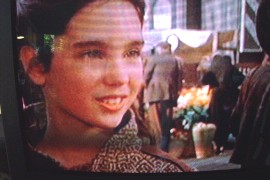
Here is Jennifer Connelly as she appeared in 1984 in Sergio Leone's Once Upon a Time in America, playing the part of Deborah Gelly, who grows up to be a theatrical star (played by Elizabeth McGovern) and Robert DeNiro's great lifelong love, whom he angrily rapes in a limousine—a characteristic act for Noodles Arronson, a Jewish gangster.
Cute, eh?

And here she is, say, fifteen years later, in a studio still. Ah, little girls grow up, don't they? (Let me count the ways.)
The movie, incidentally, is a great one in its original, or uncut, version, now available on two-disc DVD.
Roger Ebert said about the original it was a great movie and rated it four-stars (I guess that was the forerunner of "two thumbs up.")
The version we all saw in theaters and on our VCRs was cut to about 90 minutes, an act constituting "a travesty," to quote from Ebert's again. The cut version is highly confusing and often makes no sense.
He was right. The uncut version is well worth the long viewing (four hours!), and is accompanied by a detailed commentary by Richard Shickel that helps explain the remaining ambiguities.
You can watch the film in its entirety, or you can watch it with commentary, somewhat truncated. It is edifying to do it both ways, with a few days rest and some sleep in between.
- - Comments ()
...
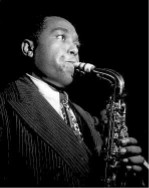
Happy Birthday, Bird!
Charlie Parker is 83 years old today!
That is, he would be, if he hadn't died at age 34, on March 15, 1955, of a massive heart attack while watching The Dorsey Brothers Show on TV in the apartment of Baroness Nica de Koenigwater-Rotchild.
For what he was doing there, one might want to watch Clint Eastwood's fine biographical film, "Bird."
It was the end of a short, eventful, talented life. Sometimes one's character is not commensurate with one's talent. Bird had apparently shaken his heroin addiction (one wonders, though) and had grown portly, puffy, from alcohol abuse. He had offended nearly everyone in music show business by his undependable, arrogant behavior. I remember as a kid watching him standing in the wings of Seattle's Metropolitan Theater, in deep shadows, waiting for the beat that led to his next solo, the reason why all of us jazz buffs were there and had bought our expensive tickets. Bird idled the time thoughtfully picking his nose.
But this isn't fair; this isn't why we are reverently gathered here today, nearly fifty years later. It is because he played the sweetest, most melodious, lilting, sonorous alto saxophone. He was rivaled by several, including Paul Desmond and, maybe before he switched to tenor, Georgie Auld, but never, never, surpassed. As a kid I thrilled to him; as an adult, plus some, I thrill to him still on the Proper reissue of his work, four CDs of about 70 minutes each, bootlegged in the UK.
- - Comments ()
...
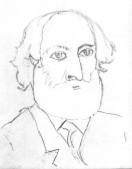
Cézanne, my sketch from a photo
A painter (for such I seem to be now) looks at art differently from the layman, the enthusiastic viewer. Similarly, one who writes fiction (as I have, years ago), reads short stories and novels in a much different way from the ordinary reader.
Both involve pleasurable hard work and a new perspective. One analyzes ceaselessly and with a high degree of concentration. "Now, how did he do that?" is always the question. Answers are not so easily obtained.
My favorite (for now, anyway) painter, Paul Cézanne, went through a lot of stages in his long career, starting out as an imitator of the painters and friends of his day, such as Camille Pissarro, and ended up among the leading Impressionists of his day. Along the way he developed various types of brushstrokes to convey what he wanted to express.
A close reading of those brushstrokes is instructive to a beginning painter such as myself. What you have to do is look long and hard, with "new eyes," so to speak. Then you go to the easel and try to do likewise.
Ah, that is the hard part.
One of Cézanne's techniques was the short stroke of the brush. It is conducted vertically, or nearly so, in a series, for the whole painting, and variations take place in the use of color, or in color mixing, and the same stroke is delivered across the canvas, horizontally, time and again. Only minor variations were permitted to himself, and if he needed to achieve depth or to introduce vertical element, he used color to do it with.
Now that you know one of Cézanne's secrets, go forth and do likewise.
- - Comments ()
...

Times two!
Yellow jackets seem to fly in squadrons, at least around our place on the lake. It had been a long time since I had been "hit" by any. Often they attack in pairs. One doesn't forget the insult.
Yesterday, while helping my male Black Lab find a tennis ball in deep scrub next door, one and his companion got me on my right shoulder blade. Bing, bang. They struck as one—a hypodermic needle jagged into my back.
Big baby that I am, I hurried home and demanded an instantaneous inspection from my wife, who was busy in the garden. (For this purpose I had uncharacteristically ripped off my T-shirt and exposed myself to the element.)
"Looks like a scrape," she said, putting on her reading glasses to peruse my wound. "Could you have run into something?"
No, no. And though I hadn't seem them, or heard them, I knew at once what they were. The man who painted our house a year ago had stumbled on a nest of them, only a few feet away from where I had met mine. But he was hypoallergic and need to rush off to a pharmacy to get some medicine, for it had happened to him before.
I had no such trouble. I suggested to my wife she apply hydrocortisone, since I couldn't reach the site, but she insisted on old-fashioned calamine lotion. It worked just fine, and the pain soon went away. By bedtime (looking at it the vain way: in a hand mirror while pointing it at a wall mirror), I saw the twin welts had almost vanished.
And now today I only think of the attack as subject matter for my blog.
Fishing has picked up a little, even though the weather and water are hot. Last night, just before Mariners baseball on TV, I picked up a ten-inch perch (big, for perch), an eleven-inch rainbow trout (my first in a month and a half), and a large-mouth bass of about a foot in length.
I was elated. And all went free.
- - Comments ()
...
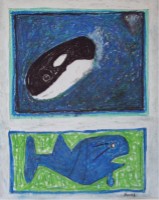
Two versions of the killer whale, the Orca.
The lower one is based on an Indian cliff drawing
Here is a haiku from last winter, along with two paintings of mine that inspired it:
Today I paint whales.
Orcas All over the place.
Tomorrow it's birds.
Killer whales won't stand still for long.
Won't your paint wash off their backs?
Not if I paint fast.
Apply the paint like water.
See, they match the sea.
Whale is gone, there is no whale.
Only water you mistook.
Actually it is two haiku, each followed by a seven-syllable unrhymed couplet, which makes the stanza a renga.
Sometimes the renga structure forms a question-and-response type of dialog. (And sometimes not, too.)
Haiku are fun to write. I often write them in the shower. I call these, "The Shower Haiku." They are usually not very good. I've got a shitpile of these.
So simple a form (5-7-5 syllables, at least in English) they are enormously complicated in what they attempt to say. That is where the Zen comes in.
Sometimes they form a koan. If not, or not successful, they pose a koan-like Zen utterance.
Enlightenment (satori) often comes suddenly, like a bolt of lightning.
Only not so gentle.
- - Comments ()
...
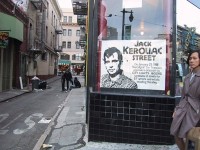
Not Maiden Lane but (however temporarily) Jack Kerouac Street
in San Francisco
Not only is Jack Kerouac a postage stamp, he is a street in San Francisco, in North Beach, or so this poster proclaims. The naming apparently was a promotion of City Lights Book Store, and what we see seems to be an unattractive alley. I think I remember it from my Berkeley days. It is just off Post Street, or is it Maiden Lane? And doesn't a fine restaurant back onto the alley, down where those guys are hanging?
Ah, yes. The Black Cat Bar, too. When I was a graduate student in English at UC, across the Bay, intellectual life was cleanly demarked into the Counter Culture folks and the Academics. There was little intermixing. We students worked hard at the literary game, while the contemporary manifestation of the literary game was taking place all around us, more or less obliviously.
Philip Dick, the great science-fiction visionary, lived down the street in San Pablo and, subsisting on stale bread and horsemeat, wrote stories that would be one day movies such as Blade Runner (see "Do Androids Dream of Electric Sheep?" And one rainy Sunday I met Allen Ginsberg at a Berkeley never-close bookstore. He was with a girl named Flo, with whom Norma (soon to be my wife) rode down with from Seattle, in Norma's light blue MGTD.
We lived in two different worlds and they were pretty much mutually exclusive. I remember him as being shy and polite—small, dark, and bespectabled. I was shy and quiet, too. When Howl came out, I rode the F Train in to SF and bought my copy.
I was outraged at what I read. And fascinated. Here was a guy who took his clothes off ("yabyum"?) when he gave poetry readings, accompanied himself on cymbal rings, smoked dope and dropped acid, and slept with his male friends. The fact that he wrote important poetry escaped me; I was busy reading Chaucer and Spenser. (What, not both at the same time? 'Fraid so. Not to mention the Old English bards. And teaching Freshman Comp.)
I was too busy to accompany Poet/Friend Mel LaFollete into SF one winter afternoon to meet Jack Kerouac at the Black Cat Bar. I had a class. . . Of course the "class" I should have attended was taught by Jack. I might have learned something. Later I did. I've read all his books. He is probably the most quintessential of American writers.
My life might have made an entirely different turn, had I met Jack. But probably I wouldn't be here today to write this blog. And of course I didn't have his demon or his talent. . . .
- - Comments ()
...
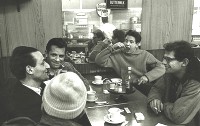
(Clockwise) Poet Gregory Corso (back of head to camera), artist Larry Rivers, Jack Kerouac, composer David Amram and poet Allen Ginsberg in New York City, 1959.
Photo: © John Cohen
Quick quote from The Dharma Bums, p. 83:
"Everything was fine with the Zen Lunatics, the nut wagon was too far away to hear us. But there was a wisdom in it all, as you'll see if you take a walk some night on a suburban street and pass house after house on both sides of the street each with the lamplight of the living room, shining golden, and inside the little blue square of the television, each living family riveting its attention on probably one show; nobody talking; silence in the yards; dogs barking at you because you pass on human feet instead of on wheels. You'll see what I mean, when it begins to appear like everybody in the world is soon going to be thinking the same way and the Zen Lunatics have joined dust, laughter on their dust lips."
I don't know about you, but to me this is mighty fine writing. And of course to Jack, being called a Lunatic, was a great compliment, when compared to the ordinary life he saw grinding all around him. (The fact that, through alcohol, he later succumbed to such a life is irrelevant here.)
The laughter he predicted he'd hear was the cosmic laughter of the Zen universe. The sound is no-sound.
- - Comments ()
...